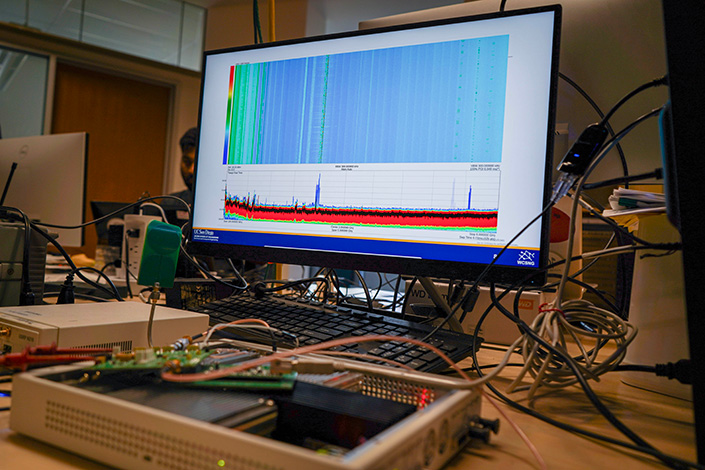Novel Device from UC San Diego Researchers Promotes Efficient, Real-Time and Secure Wireless Access
Story by:
Published Date
Article Content
A new device from the lab of Dinesh Bharadia, an affiliate of the UC San Diego Qualcomm Institute (QI) and faculty member with the Jacobs School of Engineering’s Department of Electrical and Computer Engineering, offers a fresh tool for the challenge of increasing public access to the wireless network.
Researchers developed prototype technology to filter out interference from other radio signals while sweeping underutilized spectrum frequency bands for high-traffic periods. The technology could help regulators distribute wireless access at an affordable cost during low-traffic periods.
“Through meticulous analysis of spectrum usage, we can identify underutilized segments and hidden opportunities, which, when leveraged, would lead to a cost-effective connectivity solution for users around the globe,” said Bharadia. “Crescendo stands at the forefront of this initiative, offering a low-complexity yet highly effective solution with advanced algorithms that provides robust spectrum insights for all.”
Accessing a “Quiet” Resource
When unoccupied, broadband frequencies owned by users like the U.S. Navy or military can offer wireless connection to the public or corporations at low cost. The challenge is determining when the primary owners use the frequencies, and when they would be available for public use.
Working with Associate Professor Aaron Schulman of the Jacobs School of Engineering Computer Science and Engineering Department, researchers from Bharadia’s Wireless Communications, Sensing and Networking Group created a novel device called “Crescendo.”
Crescendo features adaptive software that allows it to sweep for activity across a range of frequencies within an agency-owned wideband spectrum. The device can adapt to signal interference in real-time by dynamically adjusting which signals it receives to tune out interference from nearby towers, base stations and other sources of high power signals. The technology’s high signal fidelity also ensures that users can count on a secure connection, with any cyberattacks identified in real-time.
“Knowing what’s going on in the spectrum helps us improve communications, regulation, privacy and security,” said UC San Diego Ph.D. student and lead author Raghav Subbaraman.
Crescendo improves on an earlier design called “SweepSense,” a prototype developed by Subbaraman and colleagues in Bharadia’s lab and the Jacobs School of Engineering’s Department of Computer Science and Engineering.

In practice, Crescendo can be built using commercial off-the-shelf parts and attached to existing radio units with programmable software. Researchers can monitor a particular spectrum’s activity through color-coded graphs showing hot spots of activity in red.
“When I look at this plot, I get very excited because I can see the [wireless] spectrum as colors or visible light,” said Subbaraman. “I think as more people learn about this, it should hopefully become more accessible to them. We take it for granted that we turn on WiFi, our phone just connects, and we get the Internet. But what actually happens is what we see here.”
As a prototype, Crescendo still has areas Subbaraman would like to fine-tune, including reducing its number of components to decrease the cost of production. Subbaraman would also like to conduct field tests with multiple “spectrum sensors”—devices that measure wireless network activity—to determine whether they might work in concert.
Subbaraman presented “Crescendo: Towards Wideband, Real-Time, High-Fidelity Spectrum Sensing Systems” at the 29th Annual International Conference On Mobile Computing And Networking in Madrid, Spain.
Share This:
You May Also Like
How Climate Policies that Incentivize and Penalize Can Drive the Clean Energy Transition
Politics & SocietyStay in the Know
Keep up with all the latest from UC San Diego. Subscribe to the newsletter today.




